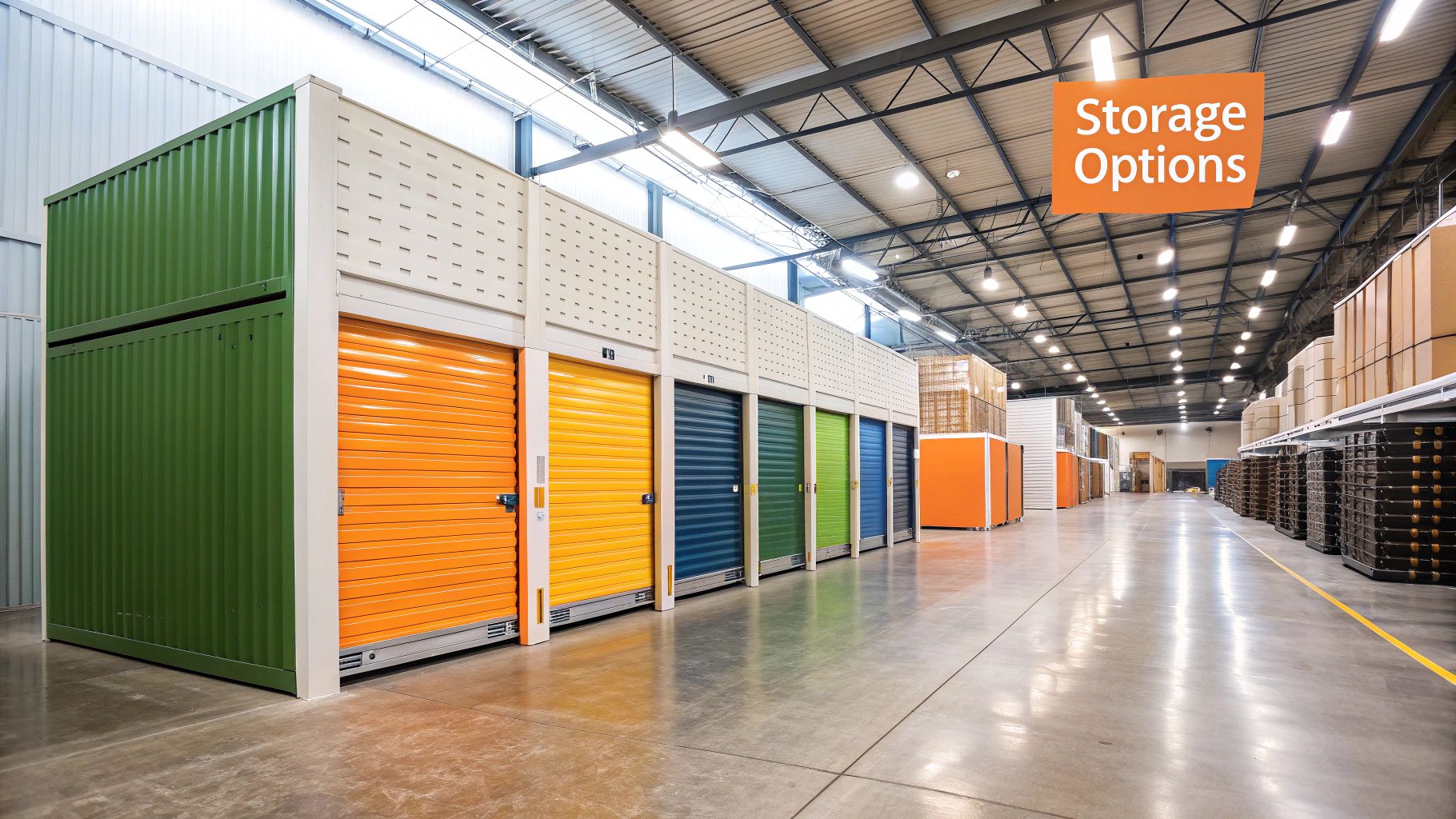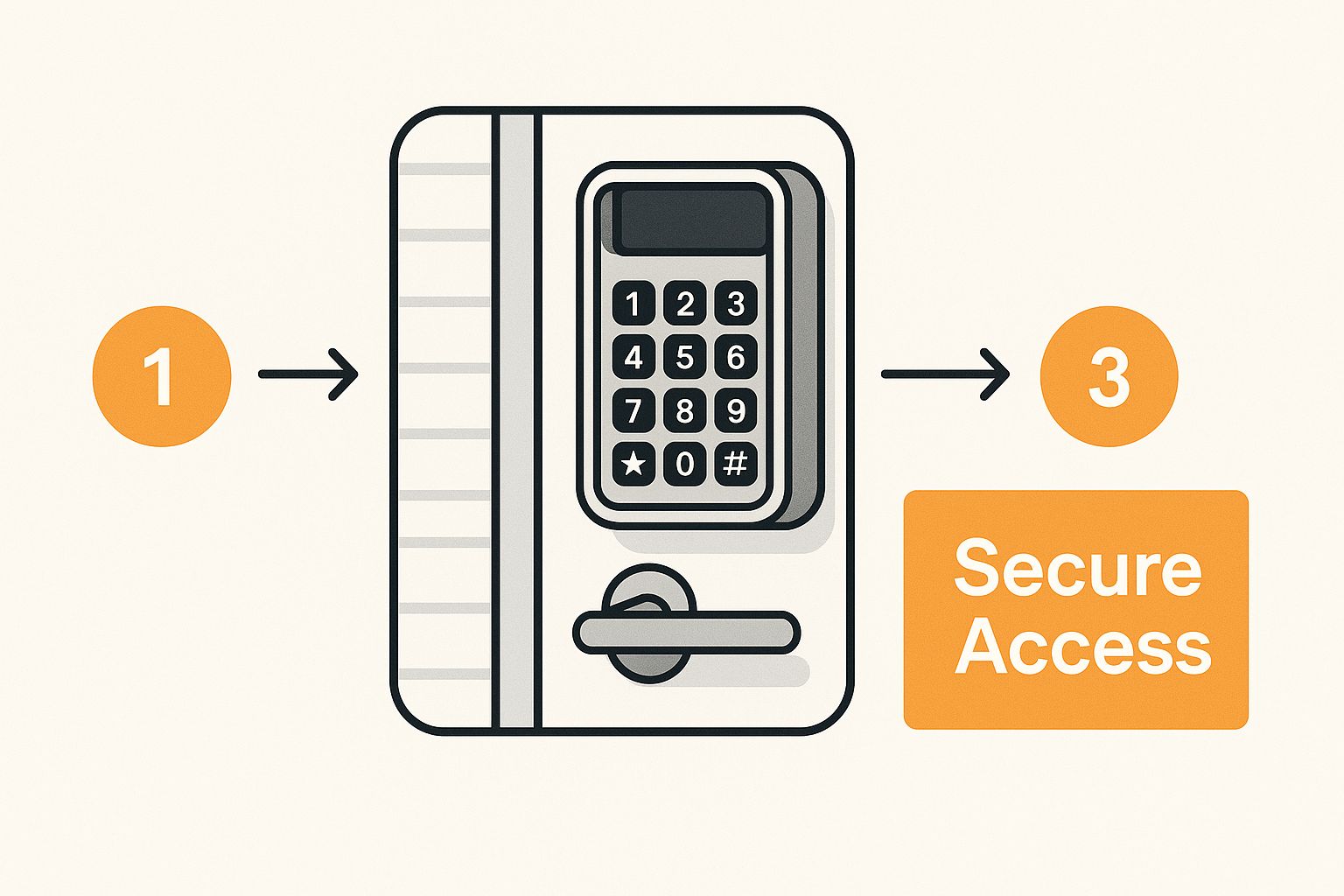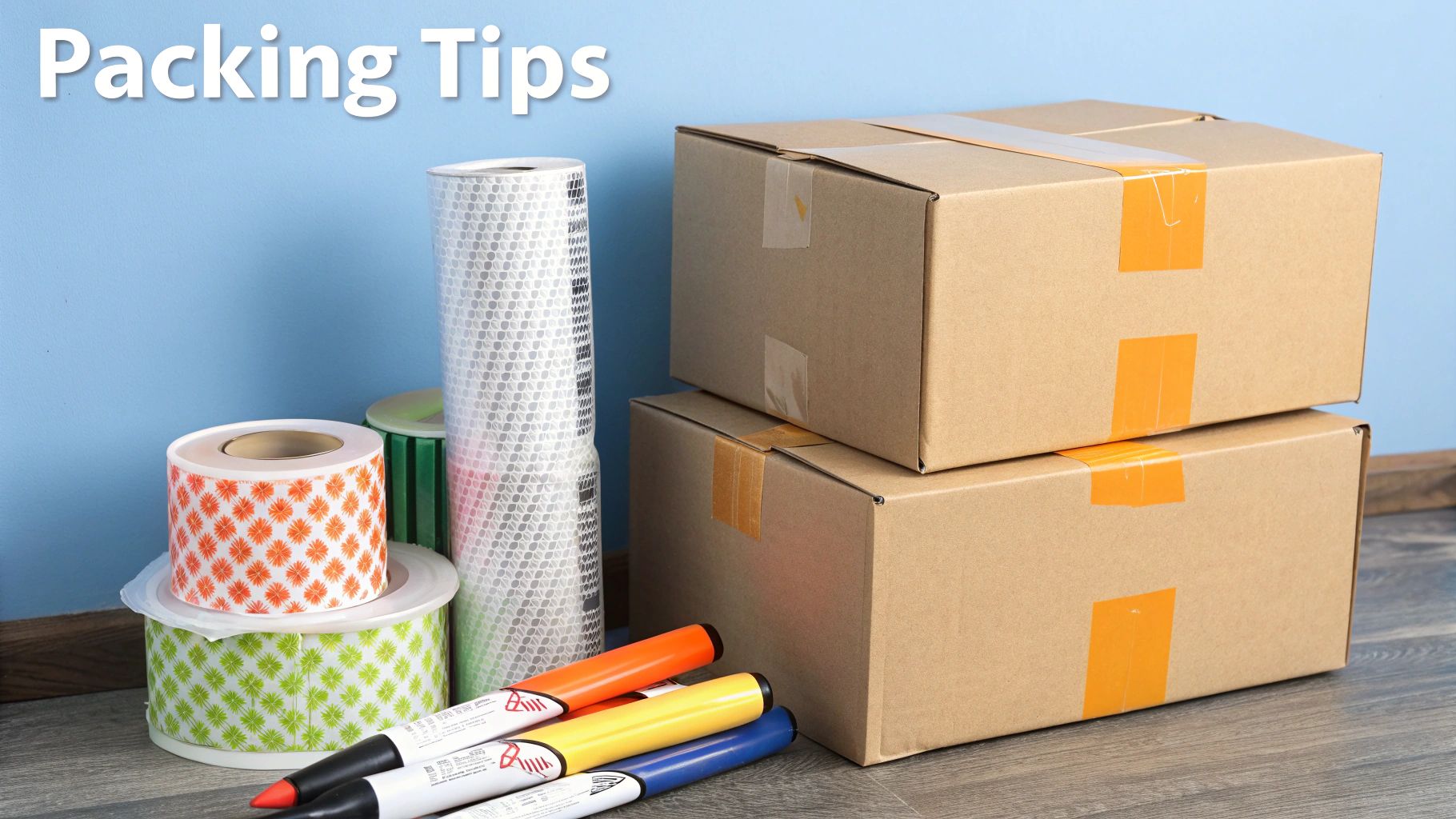Finding the right secure storage near me means knowing exactly what "secure" actually looks like in the real world. It's so much more than just a decent lock; it’s about layers of protection working together, from electronic gate access and comprehensive CCTV coverage to having actual staff on-site. Real security is what lets you walk away with total peace of mind, knowing your belongings are looked after around the clock.
What Actually Makes a Storage Unit Secure?
Before you even think about comparing prices, it's vital to get your head around the difference between basic protection and the more advanced security you might need. A simple padlock and a chain-link fence might do the trick for old garden furniture, but your priceless heirlooms or sensitive business documents demand a much higher standard of care.
Getting this right from the start saves you from two common pitfalls: either overpaying for features you don't need or, far worse, underestimating the protection your items genuinely require.
The UK self-storage industry is booming, with roughly 64.3 million square feet of available space now on the market. This growth is great because it gives you more choice than ever, but it also means you have to be more selective. With facilities competing for your business, not all of them invest equally in top-tier security.
Core Security Tiers: What to Look For
To make your search easier, it helps to think of security in tiers. At a fundamental level, there are a few essential features that should be non-negotiable.
Here are the absolute basics you should expect from any reputable facility:
- Perimeter Fencing and Gated Access: The entire property needs to be properly enclosed with controlled entry points. This usually means a gate that requires a unique PIN code to get in.
- 24/7 CCTV Monitoring: Look for high-definition cameras covering all the key areas—entrances, exits, and hallways—not just a single camera pointed at the front office.
- Good Lighting: A well-lit facility is a huge deterrent for potential intruders and makes you feel much safer, especially if you need to visit in the evening.
A truly secure facility doesn’t just react to threats; it actively works to prevent them. The best storage providers often improve their defences by conducting security threat assessments to identify and fix vulnerabilities before they ever become a problem.
Now, if you're storing items that demand extra protection—like electronics, antiques, or important files—you'll want to look for more advanced features. This could mean individually alarmed units that trigger an alert if your specific door is breached, or even climate control to guard against mould and temperature damage.
Understanding these different layers of protection is a huge part of our https://www.standbyselfstorage.co.uk/self-storage-facility-basics-guide/. Before you start your search, jot down a personal checklist of these "must-have" features. It'll make your hunt for secure storage near me far more focused and effective.
Essential Security Feature Checklist
To help you compare facilities at a glance, use this quick checklist. It breaks down the key features, what to look for, and why each one is so important for keeping your belongings safe.
| Feature | What to Look For | Why It Matters |
|---|---|---|
| Gated Access | Electronic keypad entry with unique PINs for each customer. | Ensures only authorised people can enter the premises, tracking who comes and goes. |
| 24/7 CCTV | High-definition cameras covering all access points, hallways, and driveways. | Deters criminals and provides crucial evidence if an incident occurs. |
| On-Site Staff | A visible staff presence during business hours. | Provides an immediate response to issues and adds an active layer of security. |
| Perimeter Fencing | Sturdy, high fencing around the entire property. | Acts as the first line of defence, preventing unauthorised access to the grounds. |
| Good Lighting | Bright, well-maintained lighting across the entire facility, especially at night. | Makes the facility feel safer for visitors and discourages intruders. |
| Individual Alarms | Units equipped with alarms that trigger if the door is opened without a code. | Offers an extra layer of protection specifically for your individual unit. |
| High-Quality Locks | Disc or cylinder locks provided or recommended, which are harder to tamper with. | Your personal lock is the final barrier; a robust one is essential. |
This checklist isn't exhaustive, but it covers the core components of a truly secure storage facility. If a potential site ticks all these boxes, you can be much more confident that your things are in safe hands.
How to Research and Compare Local Facilities
Right, you’ve got your security checklist sorted. Now the real search for "secure storage near me" can kick off. The trick is to go beyond a quick online search and actually understand how to read what you find. Customer reviews, for instance, are pure gold, but you have to know how to read between the lines.
Look for patterns in the feedback. A single complaint about a leaky roof might just be a one-off issue. But if three different people mention dampness over a six-month period? You've likely found a real problem. On the flip side, consistently positive comments about friendly staff or a spotless environment are huge clues that a place is well-managed.
Vetting Facilities Online
Think of a facility’s website as its digital storefront—it can tell you a lot. A professional, clear website is a great start. You should be able to find everything you need to know about their security measures, access hours, and unit sizes without having to dig for it. If they hide their pricing or make you jump through hoops just to get a quote, that could be a red flag for a lack of transparency down the road.
This infographic really drives home the importance of controlled entry, which is a key feature you should be looking for.
Secure access systems, like digital keypads, are a fundamental layer of protection. It’s what separates a genuinely secure facility from just a basic lock-up.
The Crucial In-Person Visit
Doing your homework online can only get you so far. Nothing beats actually visiting a facility in person. This is your opportunity to get a feel for the place and ask some pointed questions. Does the property seem professional and looked after? Is it clean, well-lit, and free of clutter?
An on-site visit transforms your research from theoretical to practical. It allows you to verify the claims made online and trust your instincts—if a place feels neglected or unsafe, it probably is.
When you chat with the manager, don't just ask the obvious stuff. Come prepared with a list of specific questions. For example:
- How often do you carry out pest control treatments?
- What’s your procedure if there’s a fire or a flood?
- Are staff always on-site during access hours?
Taking this methodical approach ensures your final decision is based on solid facts, not just a flashy introductory offer.
Inspecting Security Features On-Site
A slick website can promise Fort Knox, but nothing beats seeing the place with your own eyes. An on-site visit is your chance to cut through the marketing fluff and see if a facility’s security promises match reality. Think of it as your own personal inspection.
Start with the basics: the perimeter. Is the fence sturdy and intact, or are there obvious signs of disrepair that could be easily exploited? Look at the main gate. A modern, robust gate that requires a unique pin code for entry is a great sign. An old chain and padlock just doesn’t offer the same level of protection or traceability in this day and age.
Examining Surveillance and Lighting
Once you're inside, your next job is to look up. Pay close attention to the CCTV cameras. Are they modern, high-definition models positioned to cover all the key angles, or are you just seeing a few dusty, outdated cameras pointed vaguely at the entrance? Some places even use dummy cameras, which are pretty much useless.
Next, check the lighting. This is a huge, often overlooked security feature. Well-lit corridors and external areas are a massive deterrent to would-be thieves. If you can, try to time your visit for late afternoon or dusk. That way, you can see just how effective the lighting is when darkness falls.
A facility's investment in high-quality, visible security infrastructure speaks volumes. It shows they are proactive about protection rather than just reactive to incidents. This is a key differentiator when looking for secure storage near me.
Assessing Unit Construction
Finally, it’s time to get hands-on with the units themselves. The doors should be made from thick, corrugated steel, not flimsy metal that looks like it could be kicked in. Give the door a little jiggle—does it feel solid? Examine the latching mechanism. It needs to be sturdy and tamper-resistant.
Don’t be shy about asking the manager what type of locks they recommend. A facility that insists on high-security disc or cylinder locks, rather than allowing any old standard padlock, is showing a serious commitment to protecting what’s inside. It’s a small detail that tells a big story.
Decoding the True Cost of Secure Storage
That tempting monthly rate you see advertised for a storage unit? Think of it as just the starting point. To really find the best deal on secure storage near me, you need to dig a little deeper than that headline price and figure out the total cost. Otherwise, you might be in for a nasty surprise when that first bill arrives.
The reality is many facilities have a few non-negotiable add-ons that aren't always shouted about from the rooftops. These extras can easily inflate what you end up paying each month.
Look Out for Common Add-Ons
Before you sign on the dotted line, always—and I mean always—ask for a complete breakdown of every single charge. The usual suspects you’ll find are:
- Administrative Fees: A one-off charge just for getting your account set up.
- Security Deposits: This is a refundable deposit, much like you'd pay when renting a flat.
- Mandatory Insurance: Most places will insist you have insurance for your belongings.
That last point about insurance is a big one. While the facility’s standard policy will offer some basic protection, it probably won’t cover the full value of your stuff, especially if you’re storing anything valuable. It’s always a good idea to check if your current policy covers items in storage or to understand your home insurance options to get more comprehensive protection. You can also dive into our detailed guide which explains all the different factors that determine how much storage really costs in the UK.
Be wary of those introductory deals that seem a bit too good to be true. A rock-bottom price for the first month can sometimes be a tactic to get you locked into a contract before the rate jumps up significantly.
The UK self-storage industry is now a huge market, with a turnover of around £1.2 billion. One of the biggest trends driving this is the sheer convenience of booking online. With 90% of providers now offering this service, it’s become much easier to compare the total costs and lock in a deal transparently before you commit to anything.
Securing Your Unit and Moving In Smart
You’ve found the perfect facility—now it’s time to make it official and get your belongings moved in. But before you sign on the dotted line, take a moment to actually read the rental agreement. I know, I know, it's tempting to skim, but this document holds all the crucial details that can really affect your experience later on.
Pay close attention to clauses about potential price hikes, the notice period you need to give before moving out, and the list of prohibited items. Getting a clear picture of these rules upfront prevents any nasty surprises down the line. A good, reputable facility will be completely transparent about these terms, so don't be afraid to ask questions.
Organising Your Space for Safety and Access
Once the paperwork is sorted, the real work begins: moving in. How you pack and arrange your unit is just as important for security as the facility’s CCTV and gates. A little bit of smart organisation not only protects your things but also makes future visits a whole lot easier.
Always use sturdy, uniform-sized boxes if you can, and label them clearly on more than one side. Trust me, you'll thank yourself later when you're not tearing everything apart just to find one specific item. When you start loading things in, make sure to leave a central walkway so you can get to everything without playing a game of Tetris.
Here's a pro tip: place your most valuable or sentimental items at the very back of the unit, tucked behind heavier, less desirable furniture. It's a simple strategy, but it makes them the least accessible to any potential intruders and adds an extra layer of physical security.
Proper packing techniques are also a must for protecting your items from damage during the move and while in storage. For a complete walkthrough, you can learn more about how to pack your storage unit from our step-by-step guide. Following professional advice ensures everything from fragile glassware to bulky furniture stays in perfect nick. These small efforts really do make a huge difference in keeping your belongings safe for the long term.
Any Lingering Questions About Secure Storage?
When you’re looking for a safe place for your belongings, a few questions are bound to pop up. Getting them answered is the best way to move forward with confidence and know you’ve picked the right spot.
Let’s start with a big one: do you really need insurance?
The short answer is almost always yes. Most storage facilities will offer some form of insurance, but it’s often a basic plan. It might not be enough to cover your more valuable items if the worst were to happen. It's always a good idea to ring up your home insurance provider first—many policies actually extend to items you've put in storage. If yours doesn't, then getting a separate, more comprehensive policy is a smart move.
What Can I Store, and When Can I Get to It?
Another thing people often wonder about is the rules. Every facility has a list of things you can't store, but a few items are universally off-limits.
You’ll generally find you can’t store:
- Flammable or Combustible Materials: Think petrol, paint tins, fireworks, or gas canisters.
- Perishable Goods: Any food that can go off is a no-go. It’s an open invitation for pests.
- Living Things: This one’s pretty straightforward—no plants or animals allowed.
- Illegal or Hazardous Items: No surprises here. Illegal substances, weapons, and toxic materials are strictly forbidden.
It’s always best to have a quick chat with the facility manager to confirm their specific rules before you haul everything over. A five-minute conversation can save you a major headache on moving day.
The 24/7 access versus standard hours debate is a classic. While being able to get to your things anytime sounds great, it can be a security trade-off if the facility is unstaffed overnight. A site with controlled, monitored access during set hours often ends up being more secure. It really comes down to what you value more: total convenience or that extra layer of oversight.
Finding the right facility can also depend on where you are. The self-storage market is growing at different rates across the UK, with the South East expected to see the most new sites. Awareness tends to be lower outside the big cities, so a search for "secure storage near me" might take a bit more digging in some regions. You can learn more about these UK self-storage trends on storeganise.com.
Finally, always get the details on the move-out process. Most places require a notice period, usually somewhere between 7 and 30 days. This is one of those crucial bits of information buried in your rental agreement. Reading it carefully will stop you from accidentally paying for an extra month you don’t even need.
Ready to find the perfect secure unit for your needs? At Standby Self Storage, we offer transparent pricing, top-tier security, and flexible terms with no long-term commitment. Book your unit online today at https://www.standbyselfstorage.co.uk.




